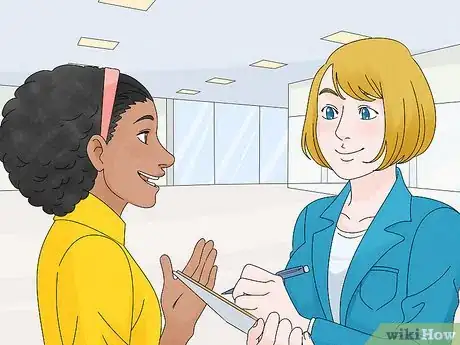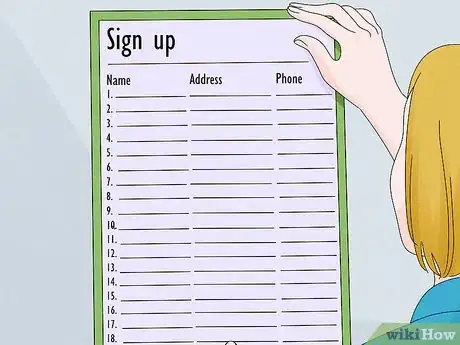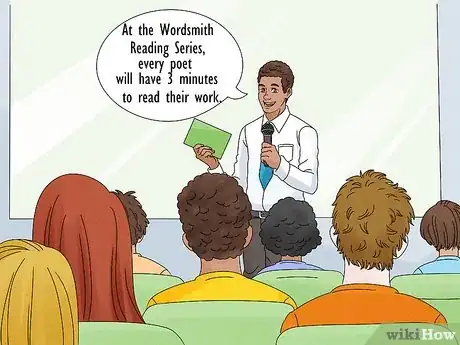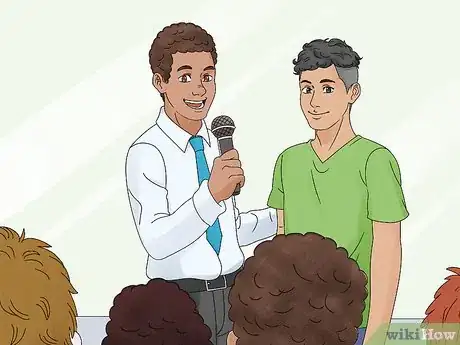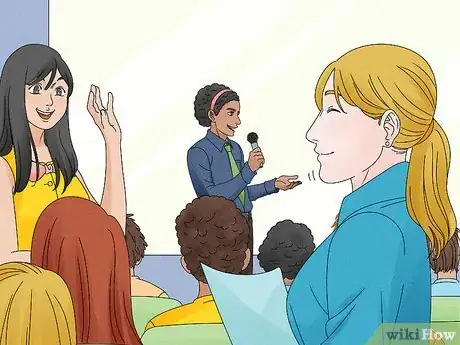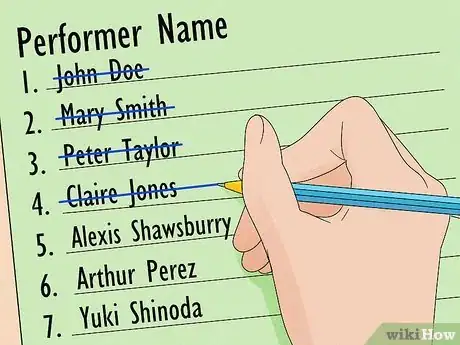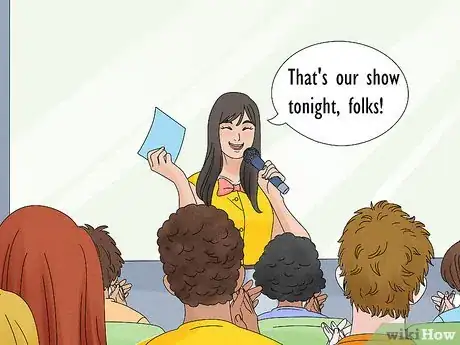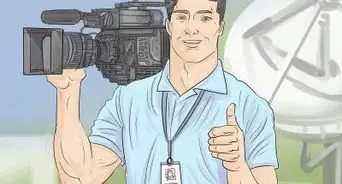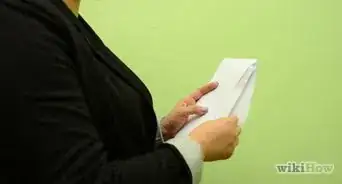This article was co-authored by wikiHow staff writer, Eric McClure. Eric McClure is an editing fellow at wikiHow where he has been editing, researching, and creating content since 2019. A former educator and poet, his work has appeared in Carcinogenic Poetry, Shot Glass Journal, Prairie Margins, and The Rusty Nail. His digital chapbook, The Internet, was also published in TL;DR Magazine. He was the winner of the Paul Carroll award for outstanding achievement in creative writing in 2014, and he was a featured reader at the Poetry Foundation’s Open Door Reading Series in 2015. Eric holds a BA in English from the University of Illinois at Chicago, and an MEd in secondary education from DePaul University.
There are 10 references cited in this article, which can be found at the bottom of the page.
This article has been viewed 15,899 times.
Learn more...
If you’ve just been nominated to replace a sick host or you’ve volunteered to lead a brand new open mic, you may be worriedly thumbing through articles trying to figure out what your job actually entails. Don’t worry—there is a solid formula every open mic host follows to run the show effectively. This isn’t to say that you can’t put your own spin on things. In fact, the best hosts lean into the job with some personality to keep the audience engaged in between acts. In any case, rest easy knowing that there’s a tried-and-true process you can follow to be an entertaining and compassionate host!
Steps
Setting up for Success
-
1Talk to the event organizer to understand the format of the open mic. Unless you set the event up yourself, there may be prerequisites for your job. Talk to the event organizer, manager, or venue owner and ask them what you need to know. They’ll tell you where you have wiggle room to be yourself, and when you need to stick to the script. They’ll also explain the rules and format for the event so you can communicate them to others.[1]
- Bring a clipboard or ask to borrow one. Keep the list of performers on this clipboard, but keep a blank sheet of paper on top to take notes, remind yourself of the rules, and jot ideas for transitions down in between sets.
- If this is a brand new open mic or you’re in charge, the rules are up to you! The first thing you need to figure out is the time limit for performers. Roughly 3 minutes per reader is a good limit for poets. You probably want to give stand-up comedians or bands 5 minutes or so.
-
2Set the sign-up list out near the welcome desk or entrance. The sign-up list is where performers volunteer to perform. Put the sign-up list in an easy-to-find location. If there’s a ticket desk, set the sign-up list there and ask the folks at the ticket desk to keep an eye on it. Alternatively, you can hang a clipboard up near the front door and put a big sign next to it. Don’t forget to leave pens out for people to sign up![2]
- Another option is to hold on to the list yourself. This is a good idea if the audience is younger and they may have questions. Just stand near the front of the stage and make an announcement every few minutes that performers can sign up with you. This also gives you the opportunity to make sure you spell and pronounce names correctly.
- You can put time slots on the sign-up sheet, but don’t expect them to be super accurate by the end of the night. It’s pretty hard to stick to a tight schedule when you have multiple acts getting on and off stage every couple of minutes.
Advertisement -
3Hang out with the audience and welcome people as they arrive. A good open mic is all about community. Talk to folks as they walk in, greet them, and encourage people to sign up. Crack jokes, enjoy yourself, and give hugs and handshakes generously. The more welcome and comfortable the audience feels, the more comfortable performers will feel. You’ll also get more audience buy-in if they feel a personal connection to you.[3]
- If this is an event that you’re already familiar with, chat it up with the regulars and make them feel valued. Take note of the newcomers and go out of your way to introduce yourself and make them feel welcome.
-
4Meet with the DJ or co-host to make sure you’re on the same page. If you’re going to be up there alone, you don’t need to coordinate with anyone else. If there’s a DJ or co-host, talk to them ahead of time to settle the details out.[4]
- If there’s a DJ, ask them if they play transition music. Are they going to fade the music in as you start introducing the next act, or is the end of the music your cue to start talking? Get their stage name as well so you can shout them out occasionally throughout the night.
- If you have a co-host, who speaks first? Who holds the list of performers? Are you going to tell any jokes together? Work things out with them to make sure nobody is stepping out of line in front of the audience. The more cohesive the two of you look together, the more engaged the audience will be.
Beginning the Open Mic
-
1Introduce yourself and welcome the audience with a warm smile. When the open mic is about to start, hop on stage with a big smile on your face. Give the audience a moment to settle down. Start by introducing the event and thanking everyone for coming out. Say a few words about yourself so that the audience knows who you are. Put a little personality in there based on the tone of the event![5]
- For a poetry open mic, you might say, “Hello everyone! Welcome to the Wordsmith Reading Series, my name is Jack Fitters; I’m a poet, teacher, and all-around fan of all things verbose.”
- At a musical open mic, you could say, “Are we ready to rock? This is the Downtown Noise Machine open mic and I’m Lindsey. I’ll be your lovely host tonight.”
- For a stand-up comedy event, you may say, “Welcome everybody and thank you for coming out! This is the Jokes on You comedy series here at The Laugh Machine Comedy Club. My name is Victor, and I’ll be running the show tonight.”
- Thank the venue or sponsors of the event if it’s appropriate. A simple, “Much love to Jimmy’s Tavern for letting us host this thing” is just fine.
-
2Explain the format of the open mic for the audience. The format of the show mainly boils down to the time limits and breaks. Mention how long each performance will be. If there’s a headliner, explain when they’ll be coming up on stage. If there are intermissions, mention that as well. This will keep people from getting up randomly and help them get a sense for the pace.[6]
- For example, you might say, “At the Wordsmith Reading Series, every poet will have 3 minutes to read their work. Please do not go over the time limit! There will be a 15-minute break at 8:30, and we’re going to get through as much of the list as possible tonight.”
- If you have a headliner, you could say, “At 9:30, we’re excited to welcome Vanessa Ray to the stage to read pieces from her new book, In the Morning Light, which is being published next month by Open City Books.”
-
3Set expectations and walk the audience through the rules. Every open mic has rules. The odds are you aren’t going to set the rules yourself, so read over them ahead of time before you get up on stage. Explain the rules in a fun and playful way to keep the audience engaged. Instead of saying, “Please silence your phone,” say something like, “If your phone goes off in the middle of a performance I will shout at you, so please keep it on vibrate to respect the people pouring their heart out up here.” If you are setting the rules, common rules for an open mic include:[7]
- Respect the equipment (no mic drops, or chair kicking).
- Turn your phone off.
- Treat performers with kindness and respect (it takes guts to get up there!).
- No profanity or bigoted language (performers and audience).
- No long disclaimers (performers shouldn’t go up and give a 5-minute dialogue before they start reading or playing).[8]
-
4Let the audience know what positive participation looks like. If it’s a serious poetry series, folk-themed open mic, or stand-up show, you’re better off just asking the audience to be quiet and respect the performer. If the audience is allowed to participate in some way, set the expectations now. Different open mics have different vibes, but audience participation is a great way to keep everyone engaged![9]
- At an upbeat poetry event or slam, you could say, “If you love what you’re hearing up there or a line just resonates so heavily that you want to show the poet some love, feel free to throw those fingers in the air and start snapping!”
- At a heavy metal open mic, you might say, “If a band is crushing it, this space in front of the stage is open for you to come up here and headbang your heart away, so don’t be shy. We’re all here to thrash together!”
- For a stand-up comedy event, you’re better off not inviting audience participation. Stand-up requires a lot of prep, and hecklers can get out of hand fast if you open the door for them to speak up.
-
5Welcome the first act to the stage and wait for them to come up. Once all of the business is out of the way, your job gets a lot easier! Take a look at the list and introduce the first performer up to the stage.[10] If there’s a microphone, wait for the performer to come up and ask if they need help with the mic. Encourage the crowd to clap and keep the energy up as they’re getting settled on stage.
- For example, you may say, “Now that the rules are out of the way, let’s put our hands together for our first stand-up, Jacob! Keep it going as he gets on up here to show him some love!”
- Young people and first-time performers may not know how to adjust the mic stand, so you may need to do it for them. If you get off stage right away, they may start fumbling with the mic stand.
Transitioning between Acts
-
1Say a few words in between performances to keep the tempo up. You don’t need to say a ton between each act, but you should say something. You could say something positive about the last act, thank everyone for coming out again, or remind everyone of the previous performer’s name. In most cases, what you say will depend on the format, energy, and style of the open mic.[11] Here are a few options:
- At a poetry event, you might say, “Thank you for that Nick, you really broke my heart with that ending. What a lovely way to finish a poem.”
- At a music-based event, you could say, “That was The Zombie Plants, they’ve been crushing it and I heard they have a new EP coming out soon. I can’t wait!”
- At a stand-up event, be a little playful. You might say, “Thank you, Wiley, that was absolutely hilarious. Please show me how to do your hair like that so I don’t have to keep going to the drive-through barber shop.”
- If you’re hosting a stand-up event and you’re a comedian yourself, feel free to throw some zingers and one-liners in there!
-
2Announce who’s “on deck” before inviting the next act on stage. In between your transition and the announcement for the next act, let the performer coming up after the next act know they need to get ready. This is commonly referred to as being “on deck,” and this little reminder will let the next performer know it’s time to get their guitar out, use the bathroom, and make their way to the stage before the next act is over to keep things moving.[12]
- You don’t need to do anything fancy here. Just say, “Sarah, you’re on deck,” or, “Flaming Whiskers, please bring your equipment backstage, you’re up after our next act.”
-
3Manage the list of performers by marking names off as you move through it. Every time an act comes up to the stage, cross their name off of your list. Review the next name so you don’t mispronounce it when you get up there. Unless you’ve been told otherwise, don’t randomize the list by bouncing around. Just go in order from top to bottom. Going randomly just makes things harder and some people intentionally show up early to go first.[13]
- If you call someone up and nobody comes to the stage, give them 5-10 seconds to show up. Then, just move on to the next name. If they were in the bathroom or something when you called them, put them back into the list at the top.
- If you don’t mark the names off, you might accidentally skip someone!
-
4Encourage the audience to be especially kind to first-timers. If you know there’s a first-timer coming on stage, feel free to tell the audience to show some extra love. This will put the performer at ease since they’ll feel the positive energy as they get up on stage, but it will also reinforce the sense of community for your event.[14]
- This is also a great way to encourage future performers. If they see all the love you’re giving to newcomers, they may sign up next time. This also will help boost the number of participants in the future since more and more people will feel comfortable at your event.
- For example, you might say, “Our next performer is getting on stage for the very first time, so please show them all of the love, protection, and affection you possibly can. It takes guts to get up here and this is a moment to celebrate, so please welcome Alexis Shawsburry!”
-
5Shut down rude audience members and problematic performers. Unfortunately, being a host means you’ll occasionally have to turn into a referee or bouncer. If a performer really crosses the line by saying or doing something hateful or dangerous, unplug the mic and shut it down. If it isn’t especially egregious but they broke a rule (like going over the time limit by 30 seconds), make a general announcement to reinforce the norm after they’re done performing.[15]
- If an audience member is interrupting and you can correct the behavior quietly and quickly without disrupting the performer, do it.
- If an audience member is being actively spiteful or disruptive, pause the set. Ask them to leave or be quiet. Then, apologize to the act and ask them to start over. Talk to the performer after the show to apologize again and explain what happened.
- This will help weed out the bad apples from returning every week. It will also reinforce the sense of community and keep the open mic feeling like a safe space for everybody. If people see you being kind and supportive, they’ll follow your lead.
-
6Interact with the audience when appropriate to keep the energy going. If a member of the audience laughs so hard at a joke that they fall out of their chair, bring it up after the set is over and say, “This guy was loving that set, I heard something dangerous happening over here.” If someone shouts out, “I love you!” while you’re on stage, call back “I love you too! You’re beautiful!” Interacting with the crowd keeps them engaged and gives them something to do in between sets.[16]
- Keep it appropriate and don’t go overboard with this. If you encourage too much interaction, things may get out of hand and you can lose track of time. Still, it’s fun to pepper these interactions into the transitions throughout the night.
-
7Keep the spotlight on the performers and don’t overdo it. Remember, your main goal here is to be the facilitator for other artists to express themselves. If you find yourself talking too long in between sets or you think you’re outshining the performers, reel it back in a bit. Being a good host is all about finding that balance to promote a healthy community![17]
-
8End the show by thanking people and plugging the next event. After the last performer is finished, get on stage and thank people for coming out for the show. Encourage them to come back and let them know when the next open mic is taking place. Thank the venue again, plug your open mic’s social media, compliment the performers, and ask people to clean up after themselves on the way out.[18]
- For example, you may say, “That’s our show tonight, folks! Thank you to all of our wonderful performers, and thank you for being such a lovely audience. Please join us for the next Downtown Noise Machine open mic next Thursday at 7 pm. Please take your trash with you on the way out, and we’ll see you next time!”
References
- ↑ https://aliceosborn.com/what-makes-a-successful-open-mic-series/
- ↑ http://annaweaver-poet.com/2017/09/05/12-tips-for-open-mic-hosts-how-to-be-flexible-fair-and-fluid/
- ↑ https://aliceosborn.com/what-makes-a-successful-open-mic-series/
- ↑ http://www.spitjournal.com/news/8-tips-running-successful-open-mic-venue/
- ↑ https://www.inc.com/jeff-haden/the-perfect-way-to-introduce-yourself-in-any-setting.html
- ↑ https://www.openmicuk.co.uk/advice/how-to-host-an-open-mic-night/
- ↑ https://vocal.media/geeks/comedy-open-mic-formats-and-etiquette
- ↑ https://theburgnews.com/culture/open-mic-magic-veteran-hosts-explain-kill-open-mic-night
- ↑ https://sonicdictionary.duke.edu/exhibits-pages/open-mic-poetry-performance-destiny-hemphill
- ↑ http://annaweaver-poet.com/2017/09/05/12-tips-for-open-mic-hosts-how-to-be-flexible-fair-and-fluid/
- ↑ http://annaweaver-poet.com/2017/09/05/12-tips-for-open-mic-hosts-how-to-be-flexible-fair-and-fluid/
- ↑ https://www.guitarworld.com/lessons/tips-for-a-great-open-mic-experience
- ↑ http://annaweaver-poet.com/2017/09/05/12-tips-for-open-mic-hosts-how-to-be-flexible-fair-and-fluid/
- ↑ http://annaweaver-poet.com/2017/09/05/12-tips-for-open-mic-hosts-how-to-be-flexible-fair-and-fluid/
- ↑ http://annaweaver-poet.com/2017/09/05/12-tips-for-open-mic-hosts-how-to-be-flexible-fair-and-fluid/
- ↑ http://annaweaver-poet.com/2017/09/05/12-tips-for-open-mic-hosts-how-to-be-flexible-fair-and-fluid/
- ↑ http://annaweaver-poet.com/2017/09/05/12-tips-for-open-mic-hosts-how-to-be-flexible-fair-and-fluid/
- ↑ https://www.openmicuk.co.uk/advice/how-to-host-an-open-mic-night/
- ↑ https://www.blackpast.org/african-american-history/mc-emcee-master-ceremonies/
